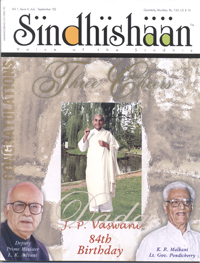![]()
THE GENESIS
From the Beginning …………
….…… to the Present
In 1931, more than a decade and a half before
the partition of India, Sadhu Vaswani founded
in Hyderabad Sind, an organisation called the ‘Sakhi Satsang’.
Sakhi Satsang, saw the light of the day in the year 1931 on the sacred day of Janmashtami. The word “Sakhi” means female friend or companion. The satsang was open to ladies and girls only; hence the name Sakhi Satsang. A picture of Sri Krishna hung on one of the walls in the hall before which incense was kept burning during satsang hours.
The whole of Hirabad resounded with music at the mystical hour of five in the morning as a band played to announce the opening of Sakhi Satsang. It was a sight for the gods, to see Vaswaniji, seated on a low wooden seat, kindling sacred havan fire in the spacious room, which was filled to capacity with women and girls. All electric lights were put off; only a single dim light was kept burning. Was this not symbolic? The Sakhi Satsang, like this single solitary light, would keep glowing in the midst of darkness in which the world lay enveloped.
Vaswaniji breathed out a soul-stirring prayer on this important occasion, the prayer was even as a song of longing-longing to meet the Lord of Love, yearning to behold the face of the Hidden One.
“Long have I been separated from Thee, beloved. Day and night have I drawn strains from the sitar of this heart. Keep not thyself concealed any longer, but come to me, Beloved, that I may speak to Thee!” he prayed and continued:
“The world is dark, desolate and dreary without Thee, Beloved. I wander far and wide in search of Thee. I stumble in the dark. Listen to my cry of longing Forgive my fathomless faults. Keep not Thyself concealed from me, but come to me. Beloved that I may speak to Thee!”
After offering this prayer Vaswaniji recited Sanskrit slokas from the Gita and then gave a touching discourse.
The sisters present in the satsang were greatly impressed by Vaswaniji’s discourses which had a freshness and fragrance of the spring breeze. Their number kept increasing day by day. Soon Parpati Kundanmal was appointed the Secretary of the Sakhi Satsang. Though brothers were admitted to the satsang in due course and Shri Gangaram became the Secretary, elder Parpati continued to be called Parpati Secretary till the end of her earth life.
The fellowship meetings were held every morning at six. The number of girls kept on growing. Gradually younger Shanti’s elder sister, Sushila, accompanied her to the satsang. The next to come was Sati B. Thadani, who later started the well-known weekly paper “Shyam” and also rendered personal service to Vaswaniji to the end. Lila B. Vaswani also joined the group. As Lila could sing moderately well and even play the harmonium, the satsang started every morning and later, every evening, with bhajans by her.
The two Shahani sisters Parpati and Kala, and the two Sujan sister Gopi and Navanidh and Sati’s sister Mithi, also attended the satsang regularly.
Parpati Shahani knew stitching and later served as tailoring teacher in the Mint School. Kala knew cooking well and prepared prasad for the satsang.
Gopi Sujan gradually identified herself with the satsang. She could sing moderately well, but when she recited passages from the scriptures she touched the hearts of the satsangis. Gopi and Navanidh’s mother had passed away and their sorrow filled hearts longed for solace. While Gopi got the much needed comfort by attending satsang, she in turn became instrumental in filling the hearts of the devotees with a feeling of peace, when she gave recitations from scriptures.
This small seed has spread its branches and gown into a huge banyan tree, serving the society in spiritual, moral, cultural, educational and social areas.
Even with the traumatic changes of the partition, that displaced entire communities, the work started by Sadhu Vaswani did not suffer a set back. In 1950, he began his efforts afresh at Pune under the name Brotherhood Association. The activities of the Association grew from strength to strength, attracting the attention of eminent humanitarians all over the world, and drawing towards itself the good wishes and willing contributions of thousands of devotees and admirers who thronged to associate themselves with such a noble cause.
After Sadhu Vaswani laid down his physical body in 1966, the Brotherhood Association was renamed the Sadhu Vaswani Mission. Dada J. P. Vaswani, the chosen disciple and spiritual heir of Sadhu Vaswani, is now the moving force and inspiration behind the Mission and its multifarious activities which have spread into branches across the globe.
IN HIS OWN WORDS One day, Sadhu Vaswani put to me this question : - “Tateh kim?” Those two Sanskrit words mean, “What then?” You will pass examinations: what then? You may have a promising career: what then? You may make money: what then? You may receive honours: what then? What then? What then? Those two words set me thinking and, gradually, brought about a change in my life. After acquiring degrees, amassing millions of dollars, gaining approbation and applause of crowds, man passes away like any other man. He does not – cannot, - carry with himself his degrees, his wealth, his prestige and power. What is the purpose of life? What is its goal? |


